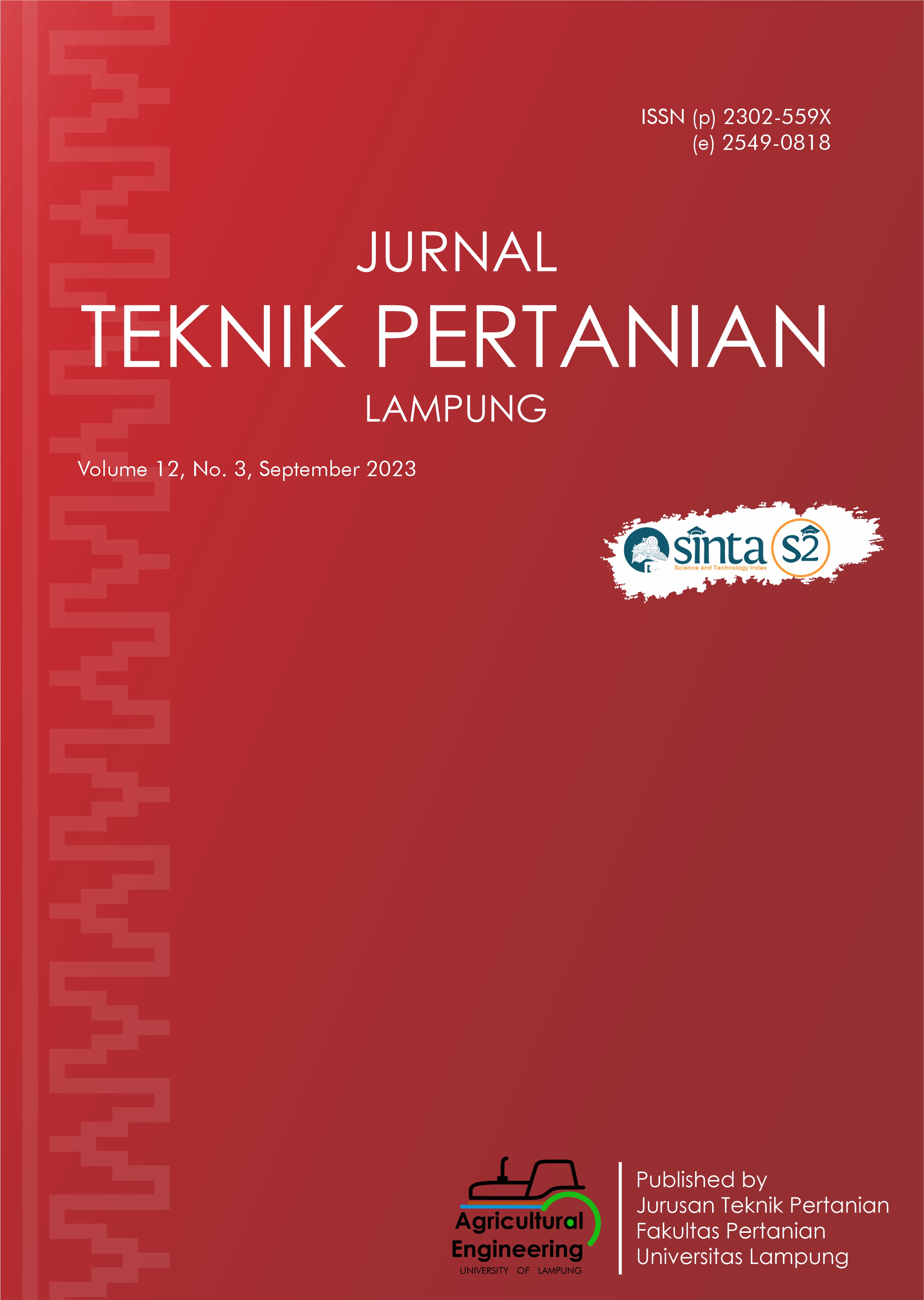Utilization of Crude Glycerol Waste from Biodiesel Production as an Additive to Improve the Quality of Tea Dreg Biopellet
DOI:
https://doi.org/10.23960/jtep-l.v12i3.571-582 Abstract View: 392
Abstract View: 392
Abstract
Biodiesel production using the transesterification method generates a large amount of crude glycerol as by-products. Crude glycerol waste can be reused and utilized as an additive in the formulation of biopellet. Tea dregs are a waste produced by the beverages industry that can be used as green fuel in the form of biopellet as an environmentally friendly energy source. This study aims to analyze and characterize biopellet from tea dregs with crude glycerol as an additive to increase the quality. The biopellet formulation contains six levels of crude glycerol composition percentage: 0% (as control), 5%, 10%, 15%, 20%, and 25%. The parameters for the quality assessment of biopellet refer to the SNI 8675:2018 standard. The best formulation of biopellet was obtained in the 10% treatment with properties of density value of 0.93 g/cm3, pellet durability of 98.09%, moisture content of 8.10%, volatile matter content of 73.37%, ash content of 6.08% and calorific value of 16.38 MJ/kg. The addition of up to 10% crude glycerol as an additive has been shown to improve the quality of tea dregs biopellet.
Keywords: Additive, Biopellet, Crude glycerol, Tea dregs.
Downloads
References
Afriani, C.D., Yufita, E., & Nurmalita. (2017). Nilai kalor briket tempurung kemiri dan kulit asam jawa dengan variasi ukuran partikel dan tekanan pengepresan. Journal of Aceh Physics Society (JAcPS), 6(1), 6-9.
Afrozi, A.S. (2018). Pengaruh konsentrasi gliserol pada campuran gliserol-air untuk produksi hidrogen secara fotokatalisis. Jurnal Ilmiah Teknik Kimia UNPAM, 2(1), 9-18. https://doi.org/ 10.32493/jitk.v2i1.1083
Ariwidyanata, R., Wibisono, Y., & Ahmad, A.M. (2019). Karakteristik fisik briket dari campuran serbuk teh dan serbuk kayu trembesi (Samanea saman) dengan perekat tepung tapioka. Jurnal Keteknikan Pertanian Tropis dan Biosistem, 7(3), 245-252. http://dx.doi.org/10.21776/ub.jkptb.2019.007.03.04
Bala-Litwiniak, A. (2020). Environmental and economic aspectsof combustion of biomass pellets containing a waste glycerol. Combustion Science and Technology, 193(1), 1-11https://doi.org/10.1080/00102202.2020.1746774.
Bantacut, T., Hendra, D., & Nurwigha, R. (2013). The quality of biopellet from combination of palm shell charcoal and palm fiber. J. Tek Ind Pert. 23(1), 1-2.
Bartocci, G., Bidini, F., Asdrubali, C., Beatrice, F., Frusteri, F., Fantozzi, F. (2018). Pyrolysis of pellets made of biomass and crude glycerol : Mass and energy balances. Renewable Energy, 124, 172-179. https://doi.org/10.1016/ j.renene.2017.06.049
Demir, V.G., Yaman, P., Efe, M.O., & Yuksel, H. (2016). Production of bio-pellets derived from sawdust and crude glycerol. International Conference on Environmental Science and Technology (ICOEST), Belgrade, Serbia, 28 September – 2 October, 2016.
DIN EN (Deutsches Institut fur Normung European) (2012). Standards 14961-2. Solid Biofuels – Fuel Specification and Classes – Part 2: Wood Pellets for Non-Industrial Use. Jerman (DE): Deutsches Institut fur Normung.
Gonzalez, W.A., Lopez, D., & Perez, J.F. (2020). Biofuel quality analysis of fallen leaf pellets: effect of moisture and glycerol contents as binders. Renewable Energy, 147, 1139-1150. https://doi.org/10.1016/j.renene.2019.09.094
Hansen, M.T., Jein, A.R., Hayes, S., & Bateman, P. (2009). English Handbook for Wood Pellet Combustion. Intelligent Energy, Europe.
Hartati, I., & Kusumaningrum, M. (2019). Kinetika pengeringan busa ampas seduhan teh. Metana: Media Komunikasi Rekayasa Proses dan Teknologi Tepat Guna, 15(1), 25–31. https://doi.org/ 10.14710/metana.v15i1.22146
Hendra, D. & Pari, G. (2000). Penyempurnaan Teknologi Pengolahan Arang. Laporan Hasil Penelitian Pusat Penelitian dan Pengembangan Hasil Hutan, Balai Penelitian dan Pengembangan Kehutanan, Bogor.
Hendra, D. (2012). Rekayasa pembuatan mesin pelet kayu dan pengujian hasilnya. Jurnal Penelitian Hasil Hutan, 30(2), 144-154. https://doi.org/10.20886/jphh.2012.30.2.144-154
Huseini, F., Solihin, S., & Pramusanto, P. (2018). Kajian kualitas batubara berdasarkan analisis proksimat, total sulfur dan nilai kalor untuk pembakaran bahan baku semen di PT. Semen Padang, Kelurahan Batu Gadang, Kecamatan Lubuk Kilangan, Kota Padang Provinsi Sumatera Barat. Prosiding Teknik Pertambangan, 4(2), 668-677.
lham, A. M., Helwani, Z, Fatra, W. (2016). Densifikasi Produk Karbonasi Pelepah Sawit Menjadi Briket Menggunakan Crude Gliserol Produk Samping Biodiesel sebagai Filler. J. FTEKNIK Universitas Riau, 3 (2).
Jamilatun, S. (2012). Sifat-sifat penyalaan dan pembakaran briket biomassa, briket batubara dan arang kayu. Jurnal Rekayasa Proses, 2(2), 37–40. https://doi.org/10.22146/jrekpros.554
Lamanda, D.D., Setyawati, D., Haida, N, Diba, F., & Roslinda, E. (2015). Karakteristik biopelet berdasarkan komposisi serbuk batang kelapa sawit dan arang kayu laban dengan jenis perekat sebagai bahan bakar alternatif terbarukan. Jurnal Hutan Lestari, 3(2). http://dx.doi.org/10.26418/jhl.v3i2.10673
Litwiniak, A.B., & Radomiak, H. (2019). Possibility of the utilization of waste glycerol as an addition to wood pellets. Waste and Biomass Valorization, 10(1), 2193–2199. https://doi.org/10.1007/s12649-018-0260-7
Mahdie, M.F., Sari, N.M., & Nisa, K. (2018). Sifat-sifat pembakaran biopelet dari limbah serbuk kayu ulin dan limbah serbuk kayu campuran (balsa dan meranti) sebagai energi terbarukan. Prosiding Seminar Nasional Lingkungan Lahan Basah, 3(2), 429-432.
Mišljenović, N., Mosbye, J., Schuller, R.B., Lekang, O.I., & Bringas, C.S. (2015). Physical quality and surface hydration properties of wood-based pellets blended with waste vegetable oil. Fuel Processing Technology, 134, 214-222. https://doi.org/10.1016/j.fuproc.2015.01.037
Nurmalasari, N., & Afiah, N. (2017). Briket kulit batang sagu (Metroxylon sagu) menggunakan perekat tapioka dan ekstrak daun kapuk (Ceiba pentandra). Jurnal Dinamika, 8(1), 1-10.
Onchieku, J.M., Chikamai, B.N., & Rao, M.S. (2012). Optimum parameters for the formulation of charcoal briquettes using bagasse and clay as binder. European Journal of Sustainable Development, 1(3), 477 – 492. https://doi.org/10.14207/ejsd.2012.v1n3p477
Patabang, D. (2011). Studi karakteristik termal briket arang kulit buah kakao. Jurnal Mekanikal, 2(1), 23-31.
Purnomo, R.H., Hower, H., & Padya, I.R. (2015). Pemanfaatan limbah biomassa untuk briket sebagai energi alternatif. Prosiding Seminar Agroindustri dan Lokakarya Nasional FKPT-TPI, 2–3.
Prabawa, I.D.G.P. (2018). Pengaruh kadar air biomassa dan suhu proses terhadap kualitas biopelet dari cangkang buah karet dan bambu ater (Gigantochloa atter). Jurnal Riset Industri Hasil Hutan, 10(2), 63-74.
Rahmadani, R., Hamzah, F, Hamzah, F.H. (2017). Pembuatan briket arang daun kelapa sawit (Elaeis guineensis jacq.) dengan perekat pati sagu (Metroxylon sago rott.). Jom Faperta Universitas Riau, 4(1), 1-11.
Rusdianto, A.S., Choiron, M., & Novijanto, N. (2014). Karakterisasi limbah industri tape sebagai bahan baku pembuatan biopelet. Industria: Jurnal Teknologi dan Manajemen, 3(1), 27-33.
Saptoadi, H. (2008). The best briquette dimension and its particle size. Asian J., Energy Environ., 9(3), 161-175.
Selvamuthu, D., & Das, D. (2018). Introduction to Statistical Methods, Design of Experiments and Statistical Quality Control. Springer Nature : Singapore Pte Ltd. ISBN: 978-981-13-1736-1. https://doi.org/10.1007/978-981-13-1736-1
SNI 8675:2018. (2018). Pelet Biomassa untuk Energi. Badan Standarisasi Nasional, Jakarta, Indonesia.
Sudiro, S., & Sugiyanto, D. (2014). Pengaruh komposisi dan ukuran serbuk briket yang terbuat dari batubara dan jerami padi terhadap karakteristik pembakaran. Jurnal Sainstech Politeknik Indonusa Surakarta, 1(2), 43-60.
Thompson, J.C., & He, B.B. (2006). Characterization of Crude Glycerol from Biodiesel Production From Multiple Feedstocks. Applied Engineering in Agriculture, 22 (2), 261-265.
Wistara, N.J., Bahri, D., & Pari, G. (2020). Biopellet properties of agathis wood fortified with its peeled off bark. IOP Conf. Series: Materials Science and Engineering, 935, 012047. doi:10.1088/1757-899X/935/1/012047
Yulianto, T., Febryano, I. G., Iryani, D. A., & Haryanto, A. (2020). Perubahan sifat fisis pelet tandan kosong kelapa sawit. Jurnal Teknik Pertanian Lampung, 9(2), 104-111. http://dx.doi.org/10.23960/jtep-l.v9i2.104-111
Downloads
Published
How to Cite
Issue
Section
License
Authors who publish with this journal agree to the following terms:
Authors retain copyright and grant the journal right of first publication with the work simultaneously licensed under a Creative Commons Attribution-ShareAlike 4.0 International Lice that allows others to share the work with an acknowledgement of the work's authorship and initial publication in this journal.
Authors are able to enter into separate, additional contractual arrangements for the non-exclusive distribution of the journal's published version of the work (e.g., post it to an institutional repository or publish it in a book), with an acknowledgement of its initial publication in this journal.
Authors are permitted and encouraged to post their work online (e.g., in institutional repositories or on their website) prior to and during the submission process, as it can lead to productive exchanges, as well as earlier and greater citation of published work (See The Effect of Open Access).
Jurnal Teknik Pertanian Lampung

JTEPL is licensed under a Creative Commons Attribution-ShareAlike 4.0 International License.













